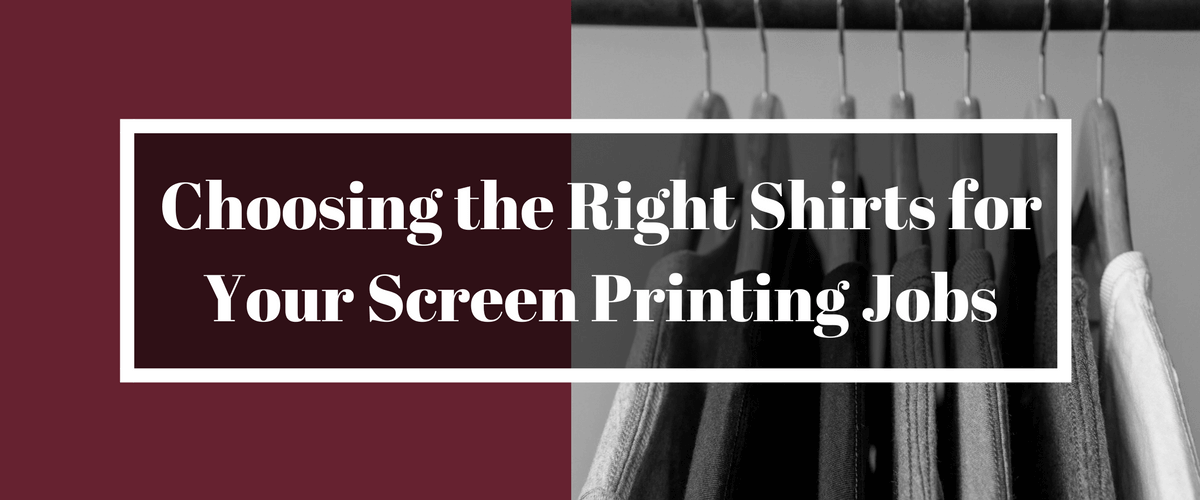Customers are more and more frequently asking for softer fabrics, eco-friendly fabrics or performance fabrics. When shopping for shirts, there is some basic knowledge that can help steer you to the right shirt for each screen printing job.
Material
Material is the defining factor for every garment. The material determines the feel, durability, thickness and printability of each shirt. The basic types of shirts used in screen printing are:
- Basic cotton. These are the bulk-order shirts that have traditionally been used in the screen printing industry. They’re cheap and durable, and they take well to screen printing. Basic cotton shirts are still the industry standard when it comes to printing for your average customer.
- Ringspun cotton. Ringspun cotton is more expensive, but it’s a higher quality option that has become more popular because it has a softer feel. Ringspun cotton is popular for customers who want a trendier or more luxurious-feeling garment.
- Polyester and synthetic blends. Polyester and other synthetic fabrics have become more popular for sports teams and athletic events because of their lightweight feel and moisture-wicking properties. They can be more challenging for printers, however, because plastisol ink sits on top of the fabric, rather than being absorbed, and dye migration can be an issue during curing. Synthetic garments present challenges that can make water-based and discharge inks impractical.
- Cotton blends. Cotton-blend options have become more and more plentiful. Cotton blends provide the moisture-wicking, lightweight benefits of synthetic fabrics with the durability of cotton. They’re generally softer than their cotton counterparts but with a more natural feel than synthetic shirts. They present similar printing challenges to 100-percent synthetic shirts.
- Eco-friendly fabrics. Eco-friendly fabrics can be made from a variety of materials, including recycled polyester, bamboo and rayon. They’ve become more and more popular as customers look for environmentally friendly clothing options. Each type of eco-friendly fabric has a different handfeel and takes to printing in different ways.
In addition to material, you also will have to look at the fabric weight and thread count of garments. Heavier weights are more rigid, durable shirts. Shirts with higher thread counts are softer and tend to print well because they are more tightly woven. Also check to see whether a garment has been preshrunk.
Tips for Choosing the Right Shirt
Screen printers eventually develop their favorite shirts. They have the go-to shirts they use for everyday jobs, and the shirts they recommend to customers with specific requests or needs. As you find your favorites, or as you search for alternatives to offer some customers, here are some tips to choosing the right shirt and helping customers to choose the right shirts:
- Request samples. It’s impossible to judge a shirt from a description on a website or in a catalog. Request samples of the shirts you’re interested in so you can get a real feel for the weight, texture and fit of the garment.
- Run test prints. You have to test new garments. Until you do, you won’t know how they react to your inks, your press and your curing process.
- Give your garments a try. One of the best ways to get a feel for sample shirts is to give them a wear after you’ve printed on them. Run them through the washer and dryer. Then, you’ll know how they wear, how they wash and how they hold up.
- Stock samples for your customers. Just like it’s hard for you to choose from a catalog or website, it’s hard for your customers. While it’s impossible to keep a catalog’s worth of samples, keep samples on hand of your most popular and your go-to shirts so customers can see and feel them.
Once you do your research and give some garments a test drive on your presses, you’ll find your line-up of shirts you feel comfortable printing with and confident recommending to your customers.
Looking for more info on different types of apparel? Check out these blog posts:
A Screen Printer’s Guide to Environmentally-Friendly Apparel
Overcoming the Challenges of Screen Printing Athletic Apparel




